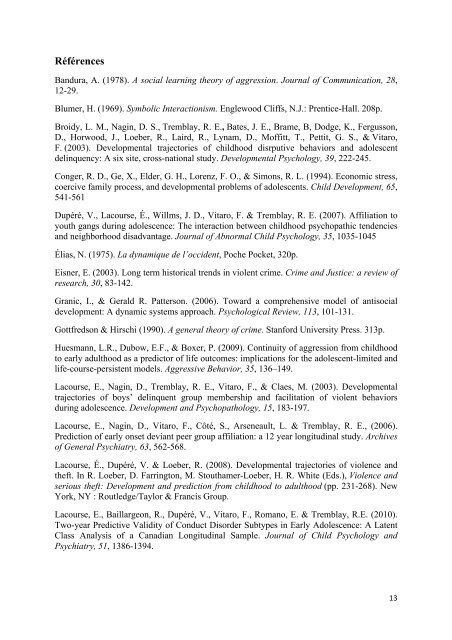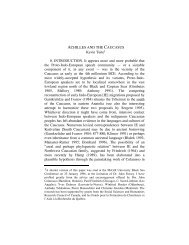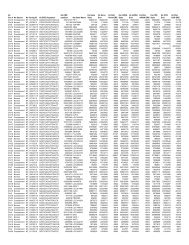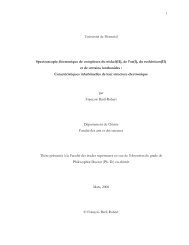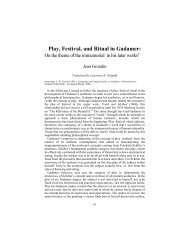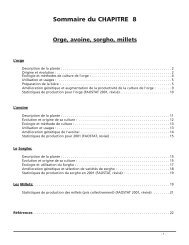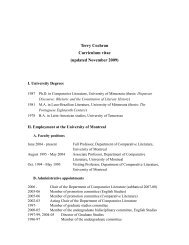1. La criminologie développementale
1. La criminologie développementale
1. La criminologie développementale
Create successful ePaper yourself
Turn your PDF publications into a flip-book with our unique Google optimized e-Paper software.
Références<br />
Bandura, A. (1978). A social learning theory of aggression. Journal of Communication, 28,<br />
12-29.<br />
Blumer, H. (1969). Symbolic Interactionism. Englewood Cliffs, N.J.: Prentice-Hall. 208p.<br />
Broidy, L. M., Nagin, D. S., Tremblay, R. E., Bates, J. E., Brame, B, Dodge, K., Fergusson,<br />
D., Horwood, J., Loeber, R., <strong>La</strong>ird, R., Lynam, D., Moffitt, T., Pettit, G. S., & Vitaro,<br />
F. (2003). Developmental trajectories of childhood disrputive behaviors and adolescent<br />
delinquency: A six site, cross-national study. Developmental Psychology, 39, 222-245.<br />
Conger, R. D., Ge, X., Elder, G. H., Lorenz, F. O., & Simons, R. L. (1994). Economic stress,<br />
coercive family process, and developmental problems of adolescents. Child Development, 65,<br />
541-561<br />
Dupéré, V., <strong>La</strong>course, É., Willms, J. D., Vitaro, F. & Tremblay, R. E. (2007). Affiliation to<br />
youth gangs during adolescence: The interaction between childhood psychopathic tendencies<br />
and neighborhood disadvantage. Journal of Abnormal Child Psychology, 35, 1035-1045<br />
Élias, N. (1975). <strong>La</strong> dynamique de l’occident, Poche Pocket, 320p.<br />
Eisner, E. (2003). Long term historical trends in violent crime. Crime and Justice: a review of<br />
research, 30, 83-142.<br />
Granic, I., & Gerald R. Patterson. (2006). Toward a comprehensive model of antisocial<br />
development: A dynamic systems approach. Psychological Review, 113, 101-13<strong>1.</strong><br />
Gottfredson & Hirschi (1990). A general theory of crime. Stanford University Press. 313p.<br />
Huesmann, L.R., Dubow, E.F., & Boxer, P. (2009). Continuity of aggression from childhood<br />
to early adulthood as a predictor of life outcomes: implications for the adolescent-limited and<br />
life-course-persistent models. Aggressive Behavior, 35, 136–149.<br />
<strong>La</strong>course, E., Nagin, D., Tremblay, R. E., Vitaro, F., & Claes, M. (2003). Developmental<br />
trajectories of boys’ delinquent group membership and facilitation of violent behaviors<br />
during adolescence. Development and Psychopathology, 15, 183-197.<br />
<strong>La</strong>course, E., Nagin, D., Vitaro, F., Côté, S., Arseneault, L. & Tremblay, R. E., (2006).<br />
Prediction of early onset deviant peer group affiliation: a 12 year longitudinal study. Archives<br />
of General Psychiatry, 63, 562-568.<br />
<strong>La</strong>course, É., Dupéré, V. & Loeber, R. (2008). Developmental trajectories of violence and<br />
theft. In R. Loeber, D. Farrington, M. Stouthamer-Loeber, H. R. White (Eds.), Violence and<br />
serious theft: Development and prediction from childhood to adulthood (pp. 231-268). New<br />
York, NY : Routledge/Taylor & Francis Group.<br />
<strong>La</strong>course, E., Baillargeon, R., Dupéré, V., Vitaro, F., Romano, E. & Tremblay, R.E. (2010).<br />
Two-year Predictive Validity of Conduct Disorder Subtypes in Early Adolescence: A <strong>La</strong>tent<br />
Class Analysis of a Canadian Longitudinal Sample. Journal of Child Psychology and<br />
Psychiatry, 51, 1386-1394.<br />
13


